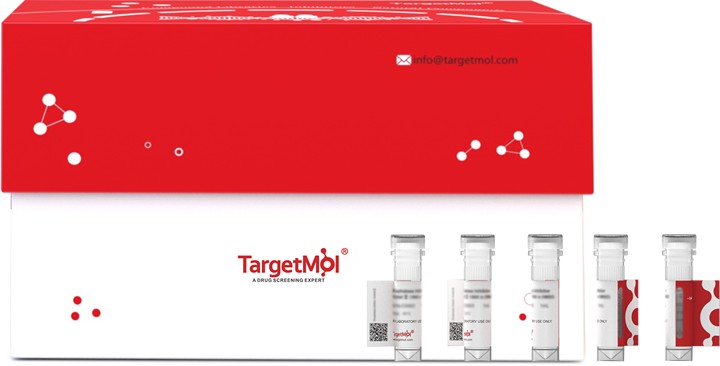- Remove All
 Your shopping cart is currently empty
Your shopping cart is currently empty
Shopping Cart
SHP-2 Protein, Mouse, Recombinant (His)
Catalog No. TMPY-03125
SHP2, also known as PTPN11, belongs to the protein-tyrosine phosphatase(PTP) family, non-receptor class 2 subfamily. PTPs catalyze the removal of phosphate groups from tyrosine residues by the hydrolysis of phosphoric acid monoesters. They dephosphorylate EGFR, JAK2 and TYK2 kinases, promoting oncogenic transformation. SHP2 is widely expressed, with highest levels in heart, brain, and skeletal muscle. SHP2 acts downstream of various receptor and cytoplasmic protein tyrosine kinases to participate in the signal transduction from the cell surface to the nucleus. It also dephosphorylates ROCK2 at Tyr-722 resulting in stimulation of its RhoA binding activity.

SHP-2 Protein, Mouse, Recombinant (His)
Catalog No. TMPY-03125
SHP2, also known as PTPN11, belongs to the protein-tyrosine phosphatase(PTP) family, non-receptor class 2 subfamily. PTPs catalyze the removal of phosphate groups from tyrosine residues by the hydrolysis of phosphoric acid monoesters. They dephosphorylate EGFR, JAK2 and TYK2 kinases, promoting oncogenic transformation. SHP2 is widely expressed, with highest levels in heart, brain, and skeletal muscle. SHP2 acts downstream of various receptor and cytoplasmic protein tyrosine kinases to participate in the signal transduction from the cell surface to the nucleus. It also dephosphorylates ROCK2 at Tyr-722 resulting in stimulation of its RhoA binding activity.
| Pack Size | Price | Availability | Quantity |
|---|---|---|---|
| 200 μg | $904 | 7-10 days |
Bulk & Custom
Add to Cart
Resource Download
Product Information
| Biological Activity | Measured by its ability to dephosphorylate a tyrosine residue in a peptide containing the EGFR Y992 phosphorylation site . The specific activity is > 1 pmoles/min/μg. |
| Description | SHP2, also known as PTPN11, belongs to the protein-tyrosine phosphatase(PTP) family, non-receptor class 2 subfamily. PTPs catalyze the removal of phosphate groups from tyrosine residues by the hydrolysis of phosphoric acid monoesters. They dephosphorylate EGFR, JAK2 and TYK2 kinases, promoting oncogenic transformation. SHP2 is widely expressed, with highest levels in heart, brain, and skeletal muscle. SHP2 acts downstream of various receptor and cytoplasmic protein tyrosine kinases to participate in the signal transduction from the cell surface to the nucleus. It also dephosphorylates ROCK2 at Tyr-722 resulting in stimulation of its RhoA binding activity. |
| Species | Mouse |
| Expression System | HEK293 Cells |
| Tag | C-His |
| Accession Number | P35235-2 |
| Synonyms | Syp,SH-PTP3,SH-PTP2,SHP-2,Shp2,SAP-2,PTP2C,PTP1D,protein tyrosine phosphatase, non-receptor type 11,AW536184,2700084A17Rik |
| Construction | A DNA sequence encoding the mouse PTPN11 (P35235-2) (Met1-Arg593) was expressed with a C-terminal polyhistidine tag. Predicted N terminal: Met |
| Protein Purity | > 90 % as determined by SDS-PAGE |
| Molecular Weight | 69.5 kDa (predicted); 65 kDa (reducing condition, due to glycosylation) |
| Endotoxin | < 1.0 EU/μg of the protein as determined by the LAL method. |
| Formulation | Lyophilized from a solution filtered through a 0.22 μm filter, containing 20 mM Tris, 0.1M NaCl, 10% Glycerol, 1 mM TCEP, pH 7.8. Typically, a mixture containing 5% to 8% trehalose, mannitol, and 0.01% Tween 80 is incorporated as a protective agent before lyophilization. |
| Reconstitution | A Certificate of Analysis (CoA) containing reconstitution instructions is included with the products. Please refer to the CoA for detailed information. |
| Stability & Storage | It is recommended to store recombinant proteins at -20°C to -80°C for future use. Lyophilized powders can be stably stored for over 12 months, while liquid products can be stored for 6-12 months at -80°C. For reconstituted protein solutions, the solution can be stored at -20°C to -80°C for at least 3 months. Please avoid multiple freeze-thaw cycles and store products in aliquots. |
| Shipping | In general, Lyophilized powders are shipping with blue ice. |
| Research Background | SHP2, also known as PTPN11, belongs to the protein-tyrosine phosphatase(PTP) family, non-receptor class 2 subfamily. PTPs catalyze the removal of phosphate groups from tyrosine residues by the hydrolysis of phosphoric acid monoesters. They dephosphorylate EGFR, JAK2 and TYK2 kinases, promoting oncogenic transformation. SHP2 is widely expressed, with highest levels in heart, brain, and skeletal muscle. SHP2 acts downstream of various receptor and cytoplasmic protein tyrosine kinases to participate in the signal transduction from the cell surface to the nucleus. It also dephosphorylates ROCK2 at Tyr-722 resulting in stimulation of its RhoA binding activity. |
Dose Conversion
You can also refer to dose conversion for different animals. More
Calculator
Tech Support
Please read the User Guide of Recombinant Proteins for more specific information.

Copyright © 2015-2025 TargetMol Chemicals Inc. All Rights Reserved.


